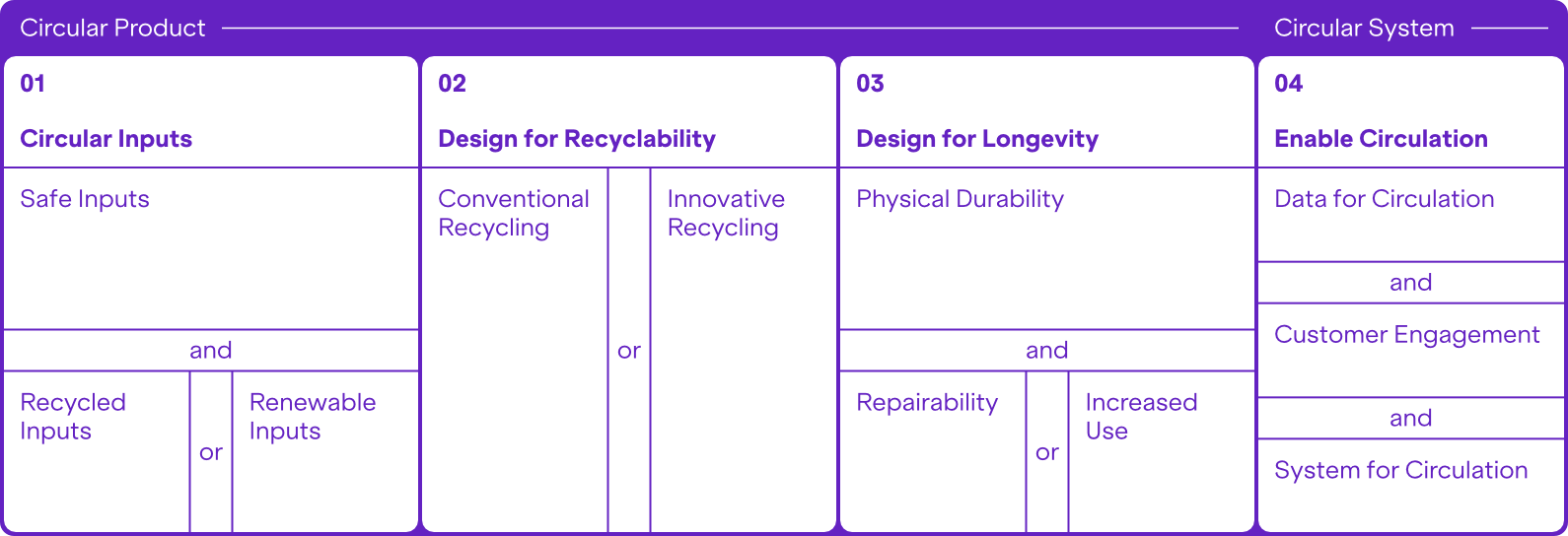Clarity for Circularity
Trusted standard to guide, certify and scale circularity beyond compliance
Actionable criteria to design and realise product circularity

The Circular Design Standard (CDS) is a trusted, industry-aligned framework developed with and for the textile industry over 5+ years. It is design-led, built to go beyond compliance, and drive circularity with a holistic, scalable approach.
The CDS consists of a comprehensive set of product and material specific criteria structured around four pillars: Circular Inputs, Design for Recyclability, Design for Longevity, Enable Circulation.
The CDS certification is available for apparel, with accessories, footwear and home textiles considered to be next in line.
Provide guidance for actionable, product and material-specific criteria to enable and scale circularity
Future-proof and continuously aligned with current and upcoming regulation, serving as a pathway to compliance and beyond
Design-led and holistic interconnecting criteria on product and system level
CDS – Four pillars of circularity

-
Design using Safe Inputs
- Compliance with one of the recognised MRSL/RSLs such as ZDHC MRSL, AFIRM RSL and more
Design using recycled and/or renewable inputs
Product level certification of sustainable fibre content:- Compliance with minimum share of certified recycled and/or renewable fibres according to fibre type and based on CDS recognised certification systems such as GOTS, GRS and more
-
Design for Conventional and/or Innovative Recycling
Product is designed to optimise fiber-to-fiber recycling through compatible fibre compositions and minimising recycling disruptors either for current conventional recycling systems or for innovative reycling based on implemented partnerships for collection, sorting, required preprocessing and recycling.- Product complies with the required minimum threshold of main material and fiber-specific limits of disruptors (e.g. blends, elastane and fillings)
- Product complies with the required limits for surface decorations, functional elements (e.g. prints, adhesive reinforcements, coatings) and other disruptors (e.g. trims, metal yarns)
-
Design for Durability
- Product complies with applicable and selected quality test results and minimum requirements, according to its product type and fabric construction
- Product complies with the applicable options of design strategies according to its product type (e.g. defined high-stress areas of the product are reinforced)
Design for Repairability and/or Increased use
Product complies with the applicable options of design strategies to facilitate- future repair and alteration and/or
- transformability in style, function or in size, adaptable to various shapes, styles, fits, aesthetics and occasions,
- aesthetic durability to strengthen the emotional connection with the user and increase the active use
-
Product features data for circulation, customer engagement and integration into systems for circulation aiming at reuse and/or recycling.
Data for Circulation
Product features Data for Transparency, Data for Reuse and Data for Recycling- Product complies with standardized requirements of data, data carrier (with criteria on type, function, usability, durability, placement) and system integration with data provision for value chain transparency and enabling the selected circulation pathway (e.g. enhanced sorting for recycling or powering a rental service).
Customer Engagement
Product features customer guidance for reuse and recycling- Product information engages users in sustainable and circular consumption through information on enhanced care instructions to extend product life, and guidance how to utilize offered circular services such as repair, recommerce, and rental, take-back for fibre recycling.
System for Circulation
- Product is embedded into a circular system for reuse and/or recycling beyond legal requirements (e.g. take-back, repair, reuse) with complying to applicable requirements on availability and effectiveness of the service to increase reuse and/or recycling
Zalando chose to accept the Circular Design Standard (CDS) to support pioneering brands in circular design, providing them with a clear and credible way to claim their products on the platform and helping customers make informed choices.Juliana Alvarez Senior Manager for Circular & Sustainable Products at Zalando
Assure readiness for evolving regulations and build your circularity compliance strategy

Developed as a common north star with and for the industry, the CDS was created in close collaboration with brands, retailers, recyclers, sorters, and industry experts.
It reflects evolving industry and regulatory requirements for circularity and enables brands to credibly design, certify, and label advanced product circularity.
The Standard’s ongoing development is overseen by a multi-stakeholder governance board with representatives from across the textile cycle.
To ensure continuous alignment with regulation, circular.fashion actively contributes to national and European projects and committees related to the Ecodesign for Sustainable Products Regulation (ESPR), Extended Producer Responsibility (EPR), and beyond.
Join leading brands, retailers, recyclers and experts to collaboratively shape a common circularity benchmark for the fashion industry
Ensure readiness for evolving EU regulation and turn compliance into measurable, circular impact
Build your future-proof compliance strategy and circularity roadmap and targets with the Circular Design Standard - Strategy Framework
Get Started
Receive information on how to certify your products according to the Circular Design Standard (CDS)
